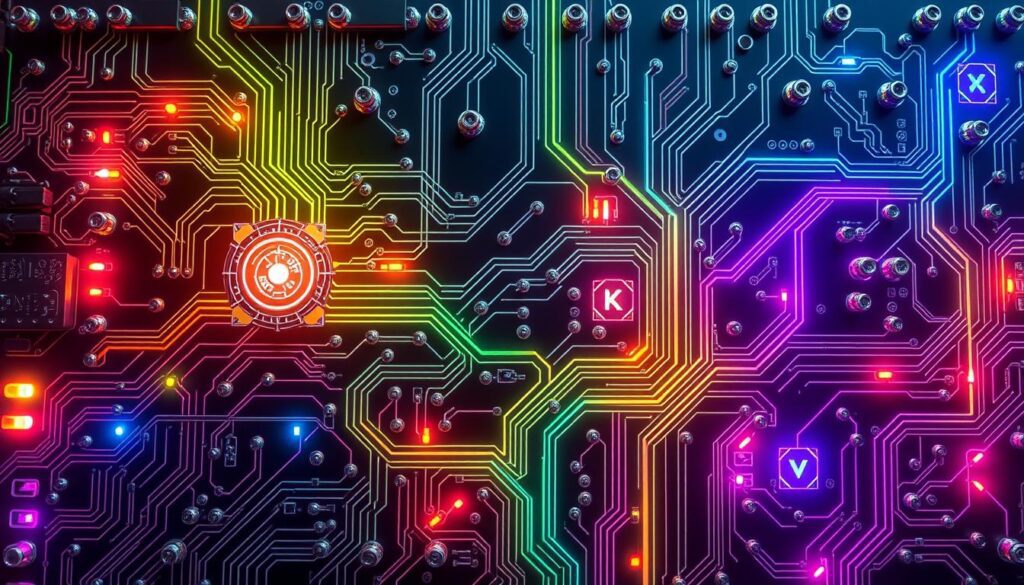In today’s world, managing power in electronics is key. Multi-voltage design is a new way to do this. It lets integrated circuits work at different voltages at the same time. This makes our devices use less power, work better, and last longer.
Multi-voltage design splits an IC into parts, each needing its own power and voltage. This way, we can give high-power parts what they need and save energy on parts that don’t use as much. It’s great for complex devices with many functions on one chip.
To use multi-voltage design, we need to know a lot about power networks, voltage control, and how to adjust voltage. By using these skills, we can make power systems that change with the task at hand. This is super important for things like phones, computers, and cars, where saving power and doing well are top priorities.
Table of Contents
Understanding the Fundamentals of Multi-Voltage Design
In today’s world of electronics, multi-voltage design is key. It lets designers manage different voltages in one place. This makes systems more efficient, powerful, and functional.
Basic Principles and Concepts
At the heart of multi-voltage design is the idea of voltage domains. These are areas in a system that work at different voltages. Designers can adjust power for each part, making sure important functions get the right voltage. This helps save power and improve performance.
Key Components in Voltage Management
Voltage regulators are crucial in multi-voltage design. They keep voltage stable and reliable across different power domains. This ensures each part of the system gets the right voltage, even when the main supply changes.
Level shifters are also vital. They help circuits at different voltages talk to each other. By converting signals, level shifters make sure data moves smoothly between domains.
Power Distribution Networks
Power distribution is key in multi-voltage design. Networks of power rails, buses, and interconnects are designed to deliver the right voltages. They aim to reduce power loss and keep signals strong.
Voltage islands add more flexibility and efficiency. These are isolated areas with their own power supplies. They let designers scale voltage and control power, saving energy and managing heat better.
| Component | Function |
|---|---|
| Voltage Regulators | Maintain stable and reliable voltage levels across power domains |
| Level Shifters | Enable communication between circuits operating at different voltage levels |
| Power Distribution Networks | Deliver required voltages to power domains while minimizing power losses and ensuring signal integrity |
| Voltage Islands | Isolated regions with dedicated power supplies, enabling independent voltage scaling and power gating |
Benefits of Implementing Multiple Voltage Domains
Using multiple voltage domains in electronics brings many benefits. It leads to better power efficiency, performance, and less heat. It also means longer battery life, which is key in today’s world.
One big plus is better power use. By setting the right voltage for each part, we use less energy. This saves money and helps the environment, making it great for many fields.
Another advantage is better performance. Matching voltages to parts lets them work their best. This means faster and more reliable systems, perfect for tasks that need quick action.
Also, using multiple voltage domains helps reduce heat. This is important in tight electronic spaces. Less heat means systems last longer and work better, making them safer and more comfortable to use.
Finally, it helps battery life in devices. By using power wisely, batteries last longer. This is great for gadgets like phones and smartwatches, making them more useful and enjoyable.
| Benefit | Description |
|---|---|
| Power Efficiency | Minimizes energy consumption and optimizes overall system power usage, leading to cost savings and a more sustainable footprint. |
| Performance Optimization | Unlocks the full potential of individual components, resulting in faster processing speeds, improved responsiveness, and enhanced overall system capabilities. |
| Heat Reduction | Minimizes the generation of excess heat, improving system reliability, lifespan, and user experience by preventing overheating. |
| Extended Battery Life | Optimizes power consumption, significantly extending the runtime of battery-powered devices and enhancing user convenience and satisfaction. |
By using multi-voltage design, we can create more efficient, powerful, and versatile electronics. These systems meet the needs of today’s users, industries, and cars.

Common Applications in Modern Electronics
The idea of multi-voltage design has changed how we use electronics every day. It’s used in everything from gadgets we carry to big machines in factories and cars. This design makes electronics better and more efficient.
Consumer Electronics
Smartphones and tablets lead the way in using multi-voltage design. They need to use power well to last longer and work better. By using different voltages for parts like the screen and processor, they last longer and work smoother.
Industrial Equipment
Industrial equipment also benefits from multi-voltage design. Things like sensors and motors in industrial automation systems use it. It helps them work better and last longer by giving them the right power.
Automotive Systems
The car world loves multi-voltage design, especially for electric vehicles (EVs) and hybrids. These cars need to manage power well for their motors and batteries. Multi-voltage design helps them use power better and work well with IoT devices inside the car.
| Sector | Applications | Benefits of Multi-Voltage Design |
|---|---|---|
| Consumer Electronics | Smartphones, tablets | Efficient power management, improved battery life, enhanced user experience |
| Industrial Equipment | Industrial automation systems | Reliable operation, precise control, improved system efficiency |
| Automotive Systems | Electric vehicles, hybrid electric vehicles | Optimized energy usage, enhanced performance, reliable operation of IoT devices |
Essential Tools and Technologies for Design Implementation
Creating efficient multi-voltage systems needs a wide range of tools. These include electronic design automation (EDA) tools, power analysis software, and simulation technologies. They help engineers cut down power use, manage voltage, and make sure designs work well.
EDA Tools for Multi-Voltage Design
Top EDA software makers have tools for multi-voltage design. They offer circuit simulators, layout editors, and power verification tools. These help designers model, analyze, and check their systems. Cadence’s Virtuoso, Synopsys’ PrimeTime, and Mentor Graphics’ Questa are some of the most used tools.
Power Analysis and Optimization
Getting power use right is key for multi-voltage designs. Software like Synopsys’ PrimePower and Cadence’s Voltus helps measure and cut down power use. They use SPICE modeling and smart algorithms to give detailed power insights, helping designers make better choices.
Advanced Simulation Techniques
Good simulation is vital for checking multi-voltage system function and performance. Designers use SPICE simulators like Cadence’s Spectre and Synopsys’ HSPICE. These tools help spot and fix problems with voltage, timing, and power before making the design real.
Using EDA tools, power analysis software, and simulation, engineers can beat multi-voltage design hurdles. They can make electronic systems that are efficient, reliable, and perform well.
| Tool Category | Example Tools | Key Capabilities |
|---|---|---|
| EDA Tools | Cadence Virtuoso, Synopsys PrimeTime, Mentor Graphics Questa | Circuit simulation, layout editing, power-aware verification |
| Power Analysis | Synopsys PrimePower, Cadence Voltus | Power consumption measurement, optimization, SPICE modeling |
| Simulation Tools | Cadence Spectre, Synopsys HSPICE | SPICE-based circuit simulation, voltage domain modeling |

Power Management Strategies in Multi-Voltage Systems
In multi-voltage design, power management is key to better performance and energy use. We’ll look at strategies like dynamic voltage and frequency scaling (DVFS), power gating, and clock domain management.
Voltage Scaling Techniques
Dynamic voltage scaling (DVS) adjusts the system’s voltage based on workload. Lowering voltage when not busy saves power without losing performance. DVFS, which also adjusts frequency, saves even more power.
Power Gating Methods
- Power gating turns off unused parts to cut down on leakage power. This is a big help in multi-voltage designs.
- It greatly reduces system power, especially in today’s chips where leakage power is a big issue.
Clock Domain Management
Managing clock domains is vital in multi-voltage systems. By dividing the design into clock domains, we can control voltage and frequency of each part. This lets us balance performance and energy use across the system.
| Technique | Description | Key Benefits |
|---|---|---|
| Dynamic Voltage Scaling (DVS) | Dynamically adjusts the operating voltage based on workload demands | Reduced power consumption without sacrificing performance |
| Dynamic Voltage and Frequency Scaling (DVFS) | Combines dynamic voltage and frequency scaling for even greater power savings | Optimizes both voltage and clock frequency for maximum energy efficiency |
| Power Gating | Selectively turns off unused circuit blocks or components to eliminate leakage power | Significant reduction in overall system power consumption |
| Clock Domain Management | Partitions the design into multiple clock domains with independent voltage and frequency control | Enables a balanced approach between performance and energy efficiency |
Design Challenges and Solutions
In multi-voltage design, we often run into problems like signal integrity, noise coupling, thermal management, and EMI. These issues can really affect how well our electronic systems work. But, with the right strategies, we can beat these challenges and make strong multi-voltage designs.
Keeping signal integrity is a big concern in multi-voltage design. When voltages change between domains, it can cause problems like ringing and overshoot. To fix this, we use techniques like controlled impedance routing and high-speed signal conditioning circuits. This helps keep the signals clear and ensures data is transmitted reliably.
Another big challenge is noise coupling between voltage domains. Noise from one domain can mess with others, causing errors or malfunctions. To solve this, we use power isolation and grounding strategies. This includes dedicated power planes, decoupling capacitors, and advanced ground-splitting techniques. These methods help keep the power and ground networks separate, reducing cross-talk and keeping our system stable.

